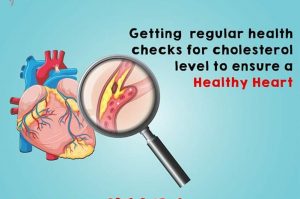Every year, World Heart Day is celebrated on the 29th of September. The day is set apart to increase awareness about cardiovascular diseases (CVDs), their prevention and treatment.
According to the World Heart Federation (WHF), “World Heart Day informs people around the globe that CVD, including heart disease and stroke, is the world’s leading cause of death claiming 18.6 million lives each year, and highlights the actions that individuals can take to prevent and control CVD. It aims to drive action to educate people that by controlling risk factors such as tobacco use, unhealthy diet and physical inactivity, at least 80% of premature deaths from heart disease and stroke could be avoided.”
What causes CVDs?
Typically, risk factors for CVDs are recognised, and not causes. This is because there is no single cause that clearly leads to the development of a CVD. Rather, multiple factors contribute to it. The more risk factors a person has, the higher their chances of having a CVD.

The risk factors are divided into modifiable and non-modifiable risk factors. The modifiable risk factors are those risks that can be controlled or altered by an individual. These include smoking, obesity, inactive lifestyle, diet and alcohol. All of these increase the chances of developing a CVD. The non-modifiable risk factors are those ones that the individual has little control over. These include age (older people are at a higher risk), ethnicity (Asians and Africans are at a higher risk) and gender (men are at a higher risk). While these groups of people are at a higher risk, other groups still have a chance of developing CVD. For example, more young people are being diagnosed with heart disease in recent times.
As the world continues to battle the COVID-19 pandemic, it is important to keep in mind that other diseases, such as CVDs, are still causing a lot of deaths and disabilities. Having this comorbidity also increases the chances of a person having severe symptoms of COVID-19. This makes it an important area to address in these times.
This year, the WHF has asked the world to ‘USE HEART TO CONNECT’. It explains that this involves ‘using your knowledge, compassion and influence to make sure you, your loved ones and the communities you’re part of have the best chance to live heart-healthy lives’. The theme of the year 2021’s World Heart day is ‘Harnessing the power of digital health to improve awareness, prevention and management of CVD globally’. Digital health has proven to be a key aspect of the race towards achieving universal health coverage across the globe.

What is Digital Health?
Digital Health is the provision of healthcare services through the intersection of healthcare and technology. It uses information and communication technologies to manage illnesses, health risks, and promote wellness. There are various forms of digital health which include – mobile health, telemedicine and wearables.
How can Digital Health contribute to the prevention of CVDs?
As stated, digital health is the use of technology in health care. The 3 key pillars of this year’s heart day are Equity, Prevention and Community, all of which can be tied to Digital health. Equity involves ensuring that everyone has access to the right information and services regarding CVD awareness, prevention and treatment. Prevention encourages people to take steps to prevent CVDs, while the community is utilising connectivity to help family and friends who live with CVD to live healthy and make their appointments as well as be there for them.
Across the different points of CVD prevention, Digital Health can be harnessed to fight CVDs.
Increasing Awareness
Increasingly, people around the world spend more time on the internet, whether via mobile devices or other computers. This is an essential way to reach more people with the right information about their cardiovascular health. As more photo-sharing, video-sharing and online community platforms are created, there should be more efforts channeled towards putting the right information online.
Additionally, these platforms make it easier to share such information in a short period. This is quite important as several dangerous pieces of information are put up by people who don’t have the right knowledge and skills about healthcare. As such, those with the right information need to be more vocal and visible. This should be done in a way that makes the average individual understand, and also encourages them to take charge of their health.
Prevention
Different digital health tools can play a role in the prevention of CVDs, including wearable devices and phone applications (apps).
Wearable devices are electronic devices worn either on the body or a piece of clothing that are used to track an individual’s vital signs and other data that relates to health and fitness. Wearable devices can be useful in tracking a person’s daily movements and activities in order to ensure that they stay active all day. Additionally, it can be used to quickly identify when vital signs such as the blood pressure are above the appropriate limits.
Phone apps can also be used to track this data. In some cases, these apps are directly connected to wearable devices using the internet. In other cases, the data has to be inputted manually. Regardless of the method of input, these applications can help to maintain a record of a person’s health data over a long period.
Treatment and management
Using telehealth/telemedicine, uncomplicated CVD cases can be monitored and followed up remotely, with the patient in the comfort of their home or office. Using telehealth, a doctor can have a consultation with a patient without both of them being in the same physical space. Also, drug prescriptions can be made virtually and the delivery made to the patient without them having to go to a physical pharmacy store. This has the potential of increasing compliance with clinic appointments and drug refills as the time spent to travel and wait in line are eliminated.
Electronic Medical Records also come to play in this regard as it helps to maintain a record of patients’ treatment progress. This ensures that all information on their treatment plan is available and this can assist the doctors and other health professionals to make better decisions in their health management.
All these further point to the need to increase access to internet connectivity as half of the world’s population are still disconnected. Disconnected hearts are at a greater risk of heart diseases and strokes.

What can you do to reduce your risk of CVD?
As stated earlier, there are modifiable risk factors when it comes to CVD. Some of the ways to reduce your risk include:
- maintain a healthy diet (low salt, low fat, low sugar, high fiber with lots of vegetables),
- exercise regularly/maintain an active lifestyle,
- maintain a healthy weight,
- stop smoking, and reduce alcohol intake.
Using digital technology, CVD can also be reduced by:
- Verifying health information available online. Ensure that the information is from a credible and authorised source. If possible, cross check with other sources to ascertain its reliability.
- Using health trackers (wearables or phone apps) to keep a record of daily activities.
- Using telehealth to book appointments with a doctor when necessary.
As we continue to work towards achieving universal health, let’s harness the power of technology to bridge the existing gaps. Let’s use heart to connect, using the power of digital to connect every heart, everywhere.

About Author:
Olakunmi is a medical doctor with interests in the intersection of data, healthcare and economics to deliver efficient and resilient health systems to achieve universal health coverage. You can connect with her via LinkedIn for conversations and collaborations – https://www.linkedin.com/in/olakunmi-ogunyemi



